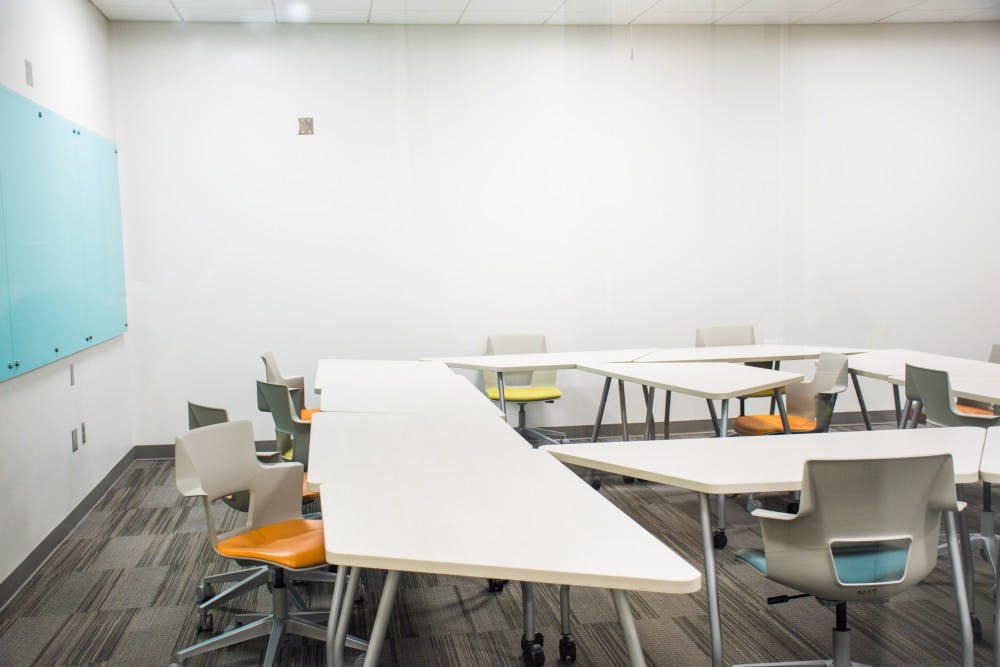Any conversation about classroom technology begins with finding a definition for what exactly classroom technology is. For Wiebke Kuhn, learning spaces and faculty development coordinator, the answer begins at the most basic level — tables and chairs in the active-learning classrooms that she maintains.
Because her role entails designing the general structure of classrooms, Kuhn has been involved in the installation of about 50 active-learning classrooms in many buildings across the University.
The topic of the tables and chairs is partially one of accessibility. For some more traditionally structured classrooms, such as those in Haley Center, the desks leave little room for those who are physically unable to sit in them, Kuhn said. However, the rolling chairs and tables of the newer active-learning classrooms allow for more accessible seating, including room for a wheelchair to be rolled under the table.
The concern of accessibility is one that reaches throughout all branches of classroom technology. Many faculty are utilizing apps that allow students or professors to remotely control Powerpoint presentations, which bridges gaps in physical ability.
Kuhn said faculty are even starting to implement augmented reality into the classroom so that students can visit remote locations when a physical trip to the destination would not be financially feasible.
Beyond removing gaps of accessibility, Kuhn said these newer technologies facilitate communication. In particular, the projection systems in these classrooms mean that the sharing of content has gotten much easier, and so has the sharing of ideas.
But the decision for what technology is brought into classrooms is not just made by the University. Projection systems require that students have smartphones or laptops, which is a reality for the majority of Auburn students. This must, then, inform the way that classes are taught.
“Any kind of factual knowledge, any kind of simple solution or memory related to knowledge you could look up with your device,” Kuhn said. “So, what does this mean for our assignments; what does this mean for what you are getting out of the classes?”
For Kuhn, it provides an opportunity to delve deeper into the subject matter and give the students more complex assignments because it’s so much easier to just Google factual information.
Similar to Kuhn, Matthew Clary, visiting assistant professor in the political science department, believes that the role of a teacher in the classroom has evolved.
“You don’t need me to be the definitive source of information in your life like back in the 80s and 90s,” Clary said. “That was our role as professors. I don’t think that’s it anymore. I think our role now is to help you, you know, take all the glut of information, determine what’s useful from it, how to think about it, how to communicate about it.”
One way that Clary has worked to accommodate the changing role of professors is through active-learning programs such as role-playing simulations. He uses the simulation for a model United Nations course.
“The logic or the goal of it is to simulate international relations as specific as possible and put students, basically they become the leadership of fictional nations in a fictional world,” Clary said.
This simulation allows for factions to form and invasions to occur, simulating the real decision-making process of international relations.
Additionally, Clary uses a newer program called Packback, which is a more conversational alternative to traditional discussion boards.
“What’s innovative about it is they have an algorithm that basically determines the quality of a post, and it assigns it a score, too,” he said. “They’re called curiosity points, and I like how that sounds interesting. They actually have like a long list of criteria that it looks for automatically the things that I would look for if I were doing it. So things like: how organized was the question in the post? Is it a yes-or-no type question? Does it rely on outside sources?”
Altough he frequently uses these newer approaches to teaching, Clary is still conscious of their limitations. He said he has concerns for increasing the cost of education and the accessibility of certain programs.
“I think that might be the challenge is how do we bring all of these, these awesome tools, into the classroom without having them be like ridiculously expensive,” Clary said.
The financial accessibility Clary has concerns for has a potential solution that lies in Auburn’s Harrison School of Pharmacy. The school faces the challenge of having a satellite campus in Mobile, Alabama, which means that their classes must be taught in a way that allows for students and professors on both campuses to collaborate.
The solution to this problem, for the School of Pharmacy, has been adopting a software called Zoom, a video-chat software. This software integrates with the TVs in most of their classrooms and conference rooms, as well as students’ and professors’ computers and mobile devices to allow for video conferencing, screen sharing and recording lectures to be viewed later. The software is provided to their students at no cost.
The opportunity to remotely view classes is not just available to students at their Mobile campus. It is also an option that is made available to students who are sick or unable to physically be in the classroom. This is useful for students who are ill so that there is less of a burden when a student can’t be physically present.
“We all have mentors in the pharmacy school, and my mentor is a faculty member that’s actually at UAB,” said Morgan Wood, third-year pharmacy student. “So, if I ever want to meet with her, I have to either Zoom from my computer or Zoom on this [conference room] system as well.”
Jacob Calahan, pharmacy student, said the software is pivotal. Students use its interface to study together and to communicate information, from putting study guides on the screen to reviewing a lecture together.
Don Davino, the pharmacy school’s instructional technology specialist, is working with technologies he said may change the face of the pharmacy school one day. He has been working with the telebot, which is a white robot with a screen that is both mobile and can display real-time video calls. He said this may be a part of the school’s future, and they are already finding ways to use it.
“We ran out of space this year,” Davino said. “For some reason, a lot of the classes with our electives, they’re just taught all the same time, and we just ran out of space. So we have some electives that are purely meeting over Zoom. They all connect in. Everybody’s got their own little box so the professor sees, and everybody else sees everybody else, and the content’s being shared.”
Much of the new technology being used in the pharmacy school is geared toward unified communication, Davino said. From Zoom to other programs like Panopto, which is utilized to access recordings through Canvas.
Davino said this communication creates an environment with no excuses for lack of participation.
“We had a professor who they had to be at a high-level meeting,”Davino said. “Their car broke down on 85, she used her phone to connect into the meeting. She’s on 85 waiting for a wrecker. She’s like, ‘Well, wait, I can use my phone.’ So she connected to the meeting because she really couldn’t miss it because she was one of the high-level people who had to be in it.”
Zoom allows students, professors, and mentors at the School of Pharmacy to work around any set of circumstances. Whether it’s a wreck on I-85 or an illness that keeps a student home for a few weeks, students and faculty can connect from any technology they have available.
“You know, life happens, right,” Davino said. “And technology helps out with all that sort of stuff.”
Do you like this story? The Plainsman doesn't accept money from tuition or student fees, and we don't charge a subscription fee. But you can donate to support The Plainsman.





